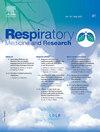Physical activity and idiopathic pulmonary fibrosis: A prospective cohort study in UK Biobank and Mendelian randomization analyses
IF 1.8
4区 医学
Q3 RESPIRATORY SYSTEM
引用次数: 0
Abstract
Introduction
The impact of physical activity on the incidence of idiopathic pulmonary fibrosis (IPF) remains less well studied. This study aimed to investigate the relationship between moderate-to-vigorous physical activity (MVPA) and the risk of developing IPF.
Methods
We analyzed data from a prospective cohort study within the UK Biobank involving 502,476 participants. Participants were categorized as meeting or not meeting the 2017 UK Physical Activity Guidelines (150 min of moderate activity or 75 min of vigorous activity per week). The cumulative incidence and hazard ratios (HRs) for IPF were analyzed using the Kaplan–Meier method, log-rank test, and Cox regression. Two-sample Mendelian randomization (MR) analyses were performed to identify potential causal links between physical activity and IPF risk.
Results
Over a median of 12.2 y follow-up, we identified 1,639 incident IPF cases and 395,172 controls. Individuals who met the physical activity guidelines had a significantly lower risk of IPF than those who did not meet the guidelines (adjusted HR = 0.843, 95 % confidence interval [CI] = 0.765–0.930).The cumulative incidence of IPF was lower in the meeting guideline group than in the nonmeeting guideline group (Log-rank P = 0.0019). Two-sample MR analysis revealed that a 1-standard deviation increase in moderate-to-vigorous physical activity was linked to a reduced IPF risk (odds ratio [OR] = 0.17, 95 % CIs = 0.04 to 0.81, P = 0.026). Moreover, an increase in the number of days per week of moderate physical activity was genetically correlated with decreased IPF risk (OR = 0.32, 95 % CIs = 0.15–0.70, P = 0.003).
Conclusion
Higher levels of moderate-to-vigorous physical activity are causally associated with a significant reduction in the risk of developing IPF.
体育锻炼与特发性肺纤维化:英国生物库前瞻性队列研究和孟德尔随机分析
导言:体育锻炼对特发性肺纤维化(IPF)发病率的影响研究较少。本研究旨在调查中到强度的体育锻炼(MVPA)与患特发性肺纤维化风险之间的关系。参与者被分为符合或不符合2017年英国体育活动指南(每周150分钟中度活动或75分钟剧烈活动)。采用 Kaplan-Meier 法、log-rank 检验和 Cox 回归分析了 IPF 的累积发病率和危险比 (HRs)。我们还进行了双样本孟德尔随机化(MR)分析,以确定体育锻炼与 IPF 风险之间的潜在因果关系。结果在中位 12.2 年的随访中,我们发现了 1,639 例 IPF 病例和 395,172 例对照。符合体育锻炼指南的个体罹患 IPF 的风险明显低于不符合指南的个体(调整后 HR = 0.843,95 % 置信区间 [CI] = 0.765-0.930),符合指南组的 IPF 累计发病率低于不符合指南组(对数秩 P = 0.0019)。双样本 MR 分析显示,中度至剧烈运动每增加 1 个标准差,就会降低 IPF 风险(几率比 [OR] = 0.17,95 % CIs = 0.04 至 0.81,P = 0.026)。此外,每周中度体力活动天数的增加与 IPF 风险的降低存在遗传相关性(OR = 0.32,95 % CIs = 0.15-0.70,P = 0.003)。
本文章由计算机程序翻译,如有差异,请以英文原文为准。
求助全文
约1分钟内获得全文
求助全文
来源期刊

Respiratory Medicine and Research
RESPIRATORY SYSTEM-
CiteScore
2.70
自引率
0.00%
发文量
82
审稿时长
50 days
 求助内容:
求助内容: 应助结果提醒方式:
应助结果提醒方式:


